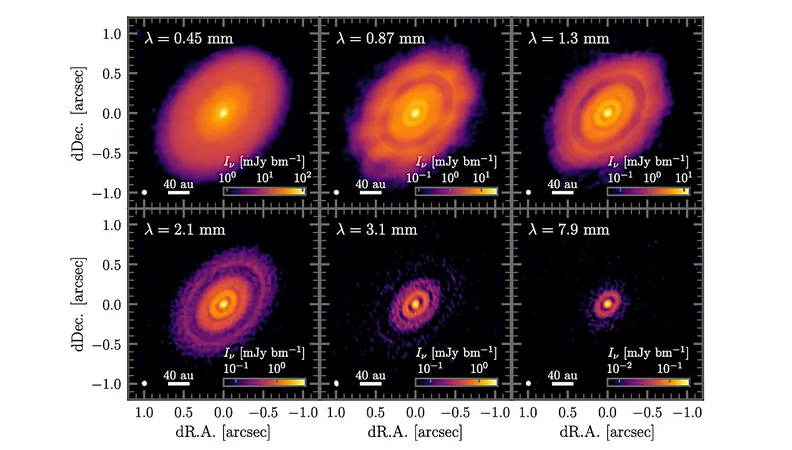
Unlocking the Mysteries of Planet Formation: Insights from the HL Tau Dust Disk
2025-07-25
Author: Siti
A Deep Dive into the HL Tau Dust Disk
In a groundbreaking study, researchers have unveiled a detailed examination of the HL Tau dust disk, a crucial area for understanding planet formation. By meticulously modeling intensity profiles across six different wavelengths—from 0.45 to 7.9 mm—scientists achieved an impressive resolution of approximately 0.05 arcseconds, equating to about 7 astronomical units (AU).
Unraveling Dust Characteristics Using Advanced Techniques
Utilizing a Markov Chain Monte Carlo (MCMC) method, the team has accurately pinpointed essential dust properties such as temperature, surface density, maximum grain size, and composition. The results indicate a notable prevalence of organics-rich dust in the outer regions (r > 40 AU) of the disk, characterized by a spectral index around 3.7. Interestingly, amorphous-carbon-rich dust also matches the observed intensity profiles.
The Case for Moderately Porous Dust
Further analysis of scattering polarization at 0.87 mm reveals that compact, amorphous-carbon-rich dust is unlikely. Instead, moderately porous dust seems to be the preferred composition. Observations suggest that beyond 40 AU, the maximum size of dust grains could reach approximately 100 micrometers, should the dust be either compact or amorphous-carbon rich.
Pebble Accretion: A Pathway to Planet Formation?
If the dust maintains a moderately porous, organics-rich profile, models predict surface densities and grain sizes conducive to a pebble accretion rate around 10 Earth masses per million years in many regions of the disk. This insight bolsters the theory that pebble accretion could be a dominant mechanism for planet formation in this stellar nursery.
Challenges for Giant Planet Core Formation
Conversely, in scenarios where the dust is amorphous-carbon-rich, the formation of giant planet cores via pebble accretion appears implausible. The low dust surface density and smaller required grain sizes complicate the process, indicating that alternative mechanisms—such as disk fragmentation driven by gravitational instability—may play a more significant role in shaping planetary bodies within the HL Tau disk.
Researchers Behind the Discovery
This pivotal research was spearheaded by an esteemed team including Takahiro Ueda, Sean M. Andrews, Carlos Carrasco-González, and others, all contributing to the ongoing quest to unravel the complexities of how planets come into existence.

 Brasil (PT)
Brasil (PT)
 Canada (EN)
Canada (EN)
 Chile (ES)
Chile (ES)
 Česko (CS)
Česko (CS)
 대한민국 (KO)
대한민국 (KO)
 España (ES)
España (ES)
 France (FR)
France (FR)
 Hong Kong (EN)
Hong Kong (EN)
 Italia (IT)
Italia (IT)
 日本 (JA)
日本 (JA)
 Magyarország (HU)
Magyarország (HU)
 Norge (NO)
Norge (NO)
 Polska (PL)
Polska (PL)
 Schweiz (DE)
Schweiz (DE)
 Singapore (EN)
Singapore (EN)
 Sverige (SV)
Sverige (SV)
 Suomi (FI)
Suomi (FI)
 Türkiye (TR)
Türkiye (TR)
 الإمارات العربية المتحدة (AR)
الإمارات العربية المتحدة (AR)